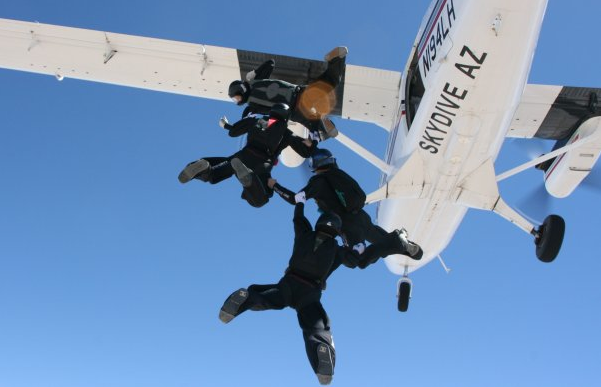
Imagine taking a leap of faith 13,000 feet in the air out of a plane and free falling for 60 seconds at 150 mph. Yes, this is a sport and not for the faint of heart. It’s skydiving.
SkyDive Arizona located in Eloy between Phoenix and Tucson is one of the biggest and busiest drop zone in the world. Over 100,000 jumps are made here each year.
“The experience was like nothing I have ever felt. Looking through the window on the way up watching the ground getting farther and farther away. Then seeing the person in front of you just get sucked out of the plane,” said Kyle Flynn of Scottsdale about his first jump at SkyDive Arizona.
In 2012 34,800 men and women were members of the United Parachute Association and the numbers will continue to grow with the popularity of the sport.
The sport of skydiving is divided into three categories: professionals, enthusiast and those who jump once for the thrill.
This is also one of the few sports where beginners can go up for the weekend to jump and sit next to a world champion on the way up.
SkyDive Arizona estimates more than 60,000 people who are able to jump solo have taken up the sport of skydiving recently.
“Like anything it’s a thrill sport that people are choosing to do,” said Susie Taylor the chief pilot at SkyDive Arizona.
The issue of safety in this sport is always an arising question from new jumpers and those interested in skydiving. “When people ask about safety it’s kind of a trick question,” said Brian Burke of SkyDive Arizona. “It’s clearly dangerous but we keep students in a restricted environment. It’s not like skiing, you can’t just buy a ticket, and you’re held up to standards for training.”
SkyDive Arizona is doing everything to make their jumps the safest. “We’ve become very proactive, our injury rate is about 1/5 of the world wide incidents,” Burke said.
Injury and death can vary in this sport; the most common accident that people like to think about is the parachute not deploying. “Equipment failure is rare, only 20 percent of the injury rate has to do with equipment,” Burke said.
The parachutes work on barometric pressure and deploy at around 3,000 to 4,000 feet. Every parachute has a reserve parachute so that if there happens to be a problem with the main parachute there is a back up.
Beginner jumpers go tandem on the first jump, which means they are strapped to a licensed professional who are all certified by the United States Parachute Association. Not only are the instructors at SkyDive Arizona licensed, but many of them are competitive jumpers, too.
To be licensed skydivers must go through a school of seven levels. If you want to jump solo usually you must make around 25 tandem jumps to begin jumping by yourself.
The reason SkyDive Arizona is the most sought after place to jump is because of Arizona’s sunny climate. The grounds at SkyDive boast three landing areas, a wind tunnel, nine airplanes and five full time pilots. SkyDive Arizona operates at least 350 days a year..
Those people not looking to jump out of an airplane yet can utilize the wind tunnel. Wind tunnels are becoming popular and you don’t have to be over 18 to use this. The wind tunnel gives the same affect of how it feels to jump out of a plane minus the 13,000 feet up in air part.
SkyDive Arizona is also home to Arizona Air Speed, this year’s world champion sky diving team.
“It’s so much more then just jumping out of a plane,” said Mark Kirkby, a member of the championship team. Kirkby and his team of five have won 12 championships in skydiving. They compete by jumping together and forming as many formations as they can while in the air. “We are completely spoiled here with the weather, great planes and so much support.”
Aside from the Arizona Airspeed team SkyDive Arizona is also the training grounds for international teams like China, Brazil, Qatar and the Red Bull Team skydive team.
If you are looking to take up sky diving as a weekend activity or profession the sport is not only risky but expensive as well. Equipment can run up to $6,000 and it does have to be replaced after a certain number of jumps. Each jump ticket also cost $25.
Prices to jump for beginners vary according to the day of the week. Weekday tickets cost $189 and weekend tickets cost $199.
From the reactions of all the first time jumpers landing safely on the ground the experience seems to well override the cost. People were screaming with excitement and dancing as they landed.
{source}![]() <iframe width=”425″ height=”350″ frameborder=”0″ scrolling=”no” marginheight=”0″ marginwidth=”0″ src=”https://maps.google.com/maps/ms?msa=0&msid=214617038628455342626.0004d6a663c7c548afc49&ie=UTF8&t=m&ll=35.603719,-96.152344&spn=49.197016,74.707031&z=3&output=embed”></iframe><br /><small>View <a href=”https://maps.google.com/maps/ms?msa=0&msid=214617038628455342626.0004d6a663c7c548afc49&ie=UTF8&t=m&ll=35.603719,-96.152344&spn=49.197016,74.707031&z=3&source=embed” style=”color:#0000FF;text-align:left”>Skydiving In the United States</a> in a larger map</small>
<iframe width=”425″ height=”350″ frameborder=”0″ scrolling=”no” marginheight=”0″ marginwidth=”0″ src=”https://maps.google.com/maps/ms?msa=0&msid=214617038628455342626.0004d6a663c7c548afc49&ie=UTF8&t=m&ll=35.603719,-96.152344&spn=49.197016,74.707031&z=3&output=embed”></iframe><br /><small>View <a href=”https://maps.google.com/maps/ms?msa=0&msid=214617038628455342626.0004d6a663c7c548afc49&ie=UTF8&t=m&ll=35.603719,-96.152344&spn=49.197016,74.707031&z=3&source=embed” style=”color:#0000FF;text-align:left”>Skydiving In the United States</a> in a larger map</small>
{/source}

